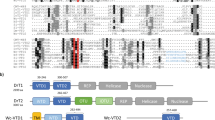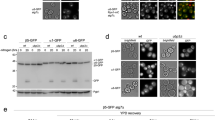Abstract
We have cloned the gene coding for a ubiquitin-protein hydrolase from the yeast Saccharomyces cerevisiae. The gene (YUH1) was isolated from a yeast genomic library by screening with an oligonucleotide probe designed from the amino acid sequence of the purified hydrolase. The YUH1 gene encodes a 26 kD protein and contains no introns. The YUH1 gene product can be overexpressed in active form in Escherichia coli and purified by a two column procedure. The purified hydrolase is capable of cleaving ubiquitin-protein fusions in vitro specifically at the ubiquitin fusion junction and requires no high energy cofactors. Fusions can also be cleaved in E. coli in strains expressing the hydrolase. Gene disruptions in haploid yeast strains have no apparent phenotypic change and ubiquitin-protein hydrolase activity in extracts is normal, indicating the existence of additional genes for ubiquitin-protein hydrolase. In vitro and in vivo cleavage of ubiquitin-protein fusions may be a useful method of producing proteins with defined ammo-termini.
This is a preview of subscription content, access via your institution
Access options
Subscribe to this journal
Receive 12 print issues and online access
$209.00 per year
only $17.42 per issue
Buy this article
- Purchase on Springer Link
- Instant access to full article PDF
Prices may be subject to local taxes which are calculated during checkout
Similar content being viewed by others
References
Rechsteiner, M. 1987. Ubiquitin-mediated pathways for intracellular proteolysis. Ann. Rev. Cell. Biol. 3:1–30.
Rechsteiner, M. 1988. Ubiquitin. Plenum Press, New York.
Finley, D. and Varshavsky, A. 1985. The ubiquitin system: functions and mechanisms. Trends Biochem. Sci. 10:343–346.
Ozkaynak, E., Finley, D. and Varshavsky, A. 1984. The yeast ubiquitin gene: head-to-tail repeats encoding a polyubiquitin precursor protein. Nature 312:663–666.
Ozkaynak, E., Finley, D., Solomon, M.J., and Varshavsky, A. 1987. The yeast ubiquitin genes: a family of natural gene fusions. EMBO J 6:1429–1439.
Liu, C.-C., Miller, H.I., and Kohr, W. 1989. Ubiquitin-protein hydrolase from yeast: purification and rapid assay. Submitted.
Goldknopf, I.L. and Busch, H. 1978. Modification of nuclear proteins: The ubiquitin-histone 2A conjugate, p. 149–180. In: The Cell Nucleus, Vol. VI, Academic Press, New York.
Levinger, L. and Varshavsky, A. 1982. Selective arrangement of ubiquitinated and D1-containing nucleosomes within the Drosophila genome. Cell 28:375–385.
Yarden, Y., Escobedo, J.A., Kwang, W.-J., Yang-Feng, T.L., Daniel, T.O., Tremble, P.M., Chen, E.Y., Ando, M.E., Harkins, R.N., Francke, U., Fried, V.A., Ullrich, A. and Williams, L.T. 1988. Structure of the receptor for platelet-derived growth factor helps define a family of closely related growth factor receptors. Nature 323:226–232.
Chin, D.T., Kuehl, L., and Rechsteiner, M. 1982. Conjugation of ubiquitin to denatured hemoglobin is proportional to the rate of hemoglobin degradation in HeLa cells. Proc. Natl. Acad. Sci. USA 79:5857–5861.
Siegelman, M., Bond, M.W., Gallatin, W.M., St. John, T., Smith, H.T., Fried, V.A. and Weissman, I.L. 1986. Cell surface molecule associated with lymphocyte homing is a ubiquitinated branched-chain glycoprotein. Science 231:823–829.
Pickart, C.M. and Rose, I.A. 1985. Ubiquitin carboxyl-terminal hydrolase acts on ubiquitin carboxyl-terminal amides. J. Biol. Chem. 260:7903–7910.
Hershko, A., Heller, H., Elias, S. and Ciechanover, A. 1983. Components of the ubiquitin-protein ligase system. J. Biol. Chem. 256:8206–8214.
Hershko, A., Ciechanover, A., Heller, H., Haas, A.L., and Rose, I. 1980. Proposed role of ATP in protein breakdown: conjugation of proteins with multiple chains of the polypeptide of ATP-dependent proteolysis. Proc. Natl. Acad. Sci. USA 77:1783–1786.
Hershko, A., Leshinsky, E., Ganoth, D., and Heller, H. 1984. ATP-dependent degradation of ubiquitin-protein conjugates. Proc. Natl. Acad. Sci. USA 81:1619–1623.
Ganoth, D., Leshinsky, E., Eytan, E., and Hershko, A. 1988. A multicomponent system that degrades proteins conjugated to ubiquitin. J. Biol. Chem. 263:12412–12419.
Rose, I.A. and Warms, J.V.B. 1983. An enzyme with ubiquitin carboxy-terminal esterase activity from reticulocytes. Biochemistry 22:4234–4237.
Pickart, C.M. and Rose, I.A. 1986. Mechanism of ubiquitin carboxyl-terminal hydrolase: borohydride and hydroxylamine inactivate in the presence of ubiquitin. J. Biol. Chem. 261:10210–10217.
Rose, I. 1988. Ubiquitin carboxyl-terminal hydrolases, p. 135–155. In: Ubiquitin. M. Rechsteiner (Ed.) Plenum Press, New York.
Finley, D., Ozkaynak, E. and Varshavsky, A. 1987. The yeast polyubiquitin gene is essential for resistance to high temperatures, starvation, and other stresses. Cell 48:1035–1046.
Jentsch, S., McGrath, J.P., and Varshavsky, A. 1987. The DNA repair gene RAD6 encodes a ubiquitin-conjugating enzyme. Nature 329:131–134.
Finley, D., Ciechanover, A. and Varshavsky, A. 1984. Thermolability of ubiquitin-activating enzyme form the mammalian cell-cycle mutant ts85. Cell 37:43–55.
Bennetzen, J.L. and Hall, B.D. 1982. Primary structure of the Saccharomyces cerevtsiae gene for alcohol dehydrogenase I. J. Biol. Chem. 257:3026–3031.
Green, M.R. 1986. Pre-mRNA splicing. Ann. Rev. Genet. 20:671–698.
Hahn, S., Hoar, E.T. and Guarente, L. 1985. Each of three “TATA elements” specifies a subset of the transcription initiation sites at the CYC-1 promoter of Saccharomyes cerevtsiae. Proc. Natl. Acad. Sci. USA 82:8562–8566.
Bachmair, A., Finley, D., and Varshavsky, A. 1986. In vivo half-life of a protein is a function of its amino-terminal residue. Science 234:179–186.
Jonnalagadda, S., Butt, T.R., Marsh, J., Sternberg, E.J., Mirabelli, C.K., Ecker, D.J., and Crooke, S.T. 1987. Expression and accurate processing of yeast penta-ubiquitin in Escherichia coli. J. Biol. Chem. 36:17750–17756.
Fasiolo, F., Bonnet, J. and Lacroute, F. 1981. Cloning of the yeast methionyl tRNA synthetase gene. J. Biol. Chem. 256:2324–2328.
Vijay-Kumar, S., Bugg, C.E., Wilkinson, K.D., Vierstra, R.D., Hatfield, P.M., and Cook, W.J. 1987. Comparisons of the three-dimensional structures of human, yeast and oat ubiquitin. J. Biol. Chem. 262:6396–6399.
Benton, W.D. and Davis, R.W. 1977. Screening lambda gt recombinant clones by hybridization to single plaques in situ. Science 196:180.
Miller, H.I. 1988. Practical aspects of preparing phage and plasmid DNA. Meth. Enzymol. Vol:145–170.
Hinnen, A., Hicks, J.B., and Fink, G.R. 1978. Transformation of yeast. Proc. Natl. Acad. Sci. USA 75:1929–1933.
Messing, J. and Vieira, J. 1982. A new pair of M13 vectors for selecting either DNA strand of double-digest restriction fragments. Gene 19:269–276.
O'Farrell, P. 1975. High resolution two-dimensional electrophoresis of proteins. J. Biol. Chem. 250:4007–4021.
Henzel, W.J., Rodrigues, H., and Watanabe, C. 1987. Computer analysis of automated Edman degradation and amino acid analysis data. J. Chromatogr. 404:41–52.
Sherman, F., Fink, G.R., and Hicks, J.B. 1981. Methods in Yeast Genetics. Cold Spring Harbor Laboratory, Cold Spring Harbor, New York.
Rothstein, R. 1983. One-step gene disruption in yeast. Meth. Enzymol. 101:202–211.
Richardson, C.C. and Tabor, S. 1985. A bacteriophage T7 RNA polymerase/promoter system for controlled exclusive expression of specific genes. Proc. Natl. Acad. Sci. USA 82:1074–1078.
Sanger, F., Nicklen, S., and Coulson, A.R. 1977. DNA sequencing with chain terminating inhibitor. Proc. Natl. Acad. Sci. USA 74:5463.
Sherwood, O.D. 1988. Relaxin, p.585–673. In: The Physiology of Reproduction. E. Knobil and J. Neill (Eds.) Raven Press, New York.
Sanger, F., Coulson, A.R., Hong, G.-F., Hill, D.F. and Peterson, G.B. 1982. Nucleotide sequence of bacteriophage λ DNA. J. Mol. Biol. 162:729–773.
Author information
Authors and Affiliations
Rights and permissions
About this article
Cite this article
Miller, H., Henzel, W., Ridgway, J. et al. Cloning and Expression of a Yeast Ubiquitin-Protein Cleaving Activity in Escherichia Coli. Nat Biotechnol 7, 698–704 (1989). https://doi.org/10.1038/nbt0789-698
Received:
Accepted:
Issue Date:
DOI: https://doi.org/10.1038/nbt0789-698



